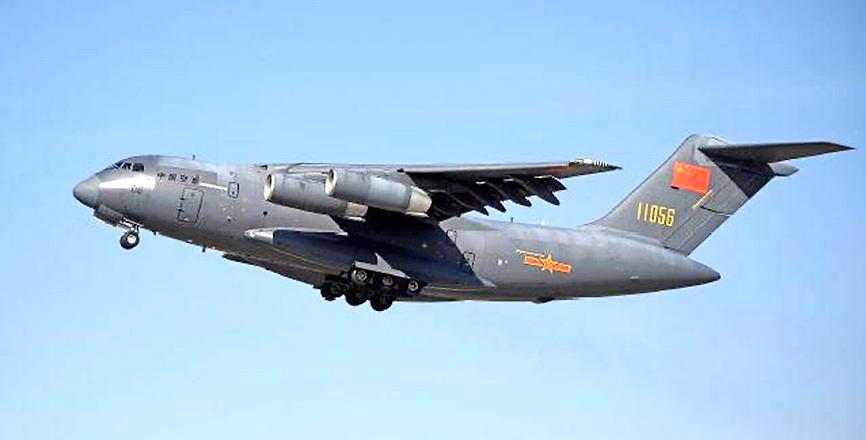Chinese warplanes made 159 incursions into Taiwan’s air defense identification zone last month, Agence France-Presse data showed, the second-highest monthly number on record.
Beijing has ramped up pressure on Taiwan since President Tsai Ing-wen (蔡英文) took office in 2016.
Over the past 14 months, the sabre-rattling has reached new peaks after Beijing began sending an increasing number of warplanes into the zone, which Chinese military aircraft had previously largely avoided.

Photo: Ministry of National Defense / EPA-EFE
The escalatory moves have heightened fears among Western allies that China could order an invasion of Taiwan, even if they consider it unlikely for now.
On Tuesday, the Pentagon unveiled plans to reinforce deployments and bases directed at China, upgrading and expanding military facilities in Guam and Australia.
In Taipei, the Ministry of National Defense began making the Chinese warplane incursions public in September last year and AFP has built a database collecting details of the flights, which have been increasing in size and frequency.
November was the third month in a row in which more than 100 warplanes have made forays.
The incursions last month included 100 by fighter jets and nine by China’s nuclear-capable H6 bombers.
Beijing has stuck to probing the southwestern part of zone.
Near-daily smaller flights means Taiwan’s fleet of fighters is regularly scrambled, while Beijing also sometimes sends larger numbers to show displeasure over specific events.
October remains the busiest month on record with 196 incursions, 149 of which were made over just four days as Beijing marked China’s National Day.
Last month saw fewer large-scale incursions, but a near-daily trickle of planes.
“The recent situation is particularly grim with almost non-stop” incursions, Minister of National Defense Chiu Kuo-cheng (邱國正) said on Monday, after a sortie by 27 Chinese aircraft the day before, the biggest of the month, but only the fifth-largest daily incursion on record.
China’s “intention is to slowly exhaust [us], to let you know that we have this power,” Chiu said.
Chiu has previously warned that military tensions between Taiwan and China are at their highest in four decades, adding that Beijing would be in a position to launch a full-scale invasion by 2025.
Since the ministry first began making the forays public, more than 1,000 flights have been made.
A defense report released by the ministry last month said that China’s “frequent manipulation of gray-zone threats” such as the warplane incursions, are aimed at “seizing Taiwan without a fight.”

Three Taiwanese airlines have prohibited passengers from packing Bluetooth earbuds and their charger cases in checked luggage. EVA Air and Uni Air said that Bluetooth earbuds and charger cases are categorized as portable electronic devices, which should be switched off if they are placed in checked luggage based on international aviation safety regulations. They must not be in standby or sleep mode. However, as charging would continue when earbuds are placed in the charger cases, which would contravene international aviation regulations, their cases must be carried as hand luggage, they said. Tigerair Taiwan said that earbud charger cases are equipped

Foreign travelers entering Taiwan on a short layover via Taiwan Taoyuan International Airport are receiving NT$600 gift vouchers from yesterday, the Tourism Administration said, adding that it hopes the incentive would boost tourism consumption at the airport. The program, which allows travelers holding non-Taiwan passports who enter the country during a layover of up to 24 hours to claim a voucher, aims to promote attractions at the airport, the agency said in a statement on Friday. To participate, travelers must sign up on the campaign Web site, the agency said. They can then present their passport and boarding pass for their connecting international

UNILATERAL MOVES: Officials have raised concerns that Beijing could try to exert economic control over Kinmen in a key development plan next year The Civil Aviation Administration (CAA) yesterday said that China has so far failed to provide any information about a new airport expected to open next year that is less than 10km from a Taiwanese airport, raising flight safety concerns. Xiamen Xiangan International Airport is only about 3km at its closest point from the islands in Kinmen County — the scene of on-off fighting during the Cold War — and construction work can be seen and heard clearly from the Taiwan side. In a written statement sent to Reuters, the CAA said that airports close to each other need detailed advanced

Tropical Storm Fung-Wong would likely strengthen into a typhoon later today as it continues moving westward across the Pacific before heading in Taiwan’s direction next week, the Central Weather Administration (CWA) said. As of 8am, Fung-Wong was about 2,190km east-southeast of Cape Oluanpi (鵝鑾鼻), Taiwan’s southernmost point, moving westward at 25kph and possibly accelerating to 31kph, CWA data showed. The tropical storm is currently over waters east of the Philippines and still far from Taiwan, CWA forecaster Tseng Chao-cheng (曾昭誠) said, adding that it could likely strengthen into a typhoon later in the day. It is forecast to reach the South China Sea